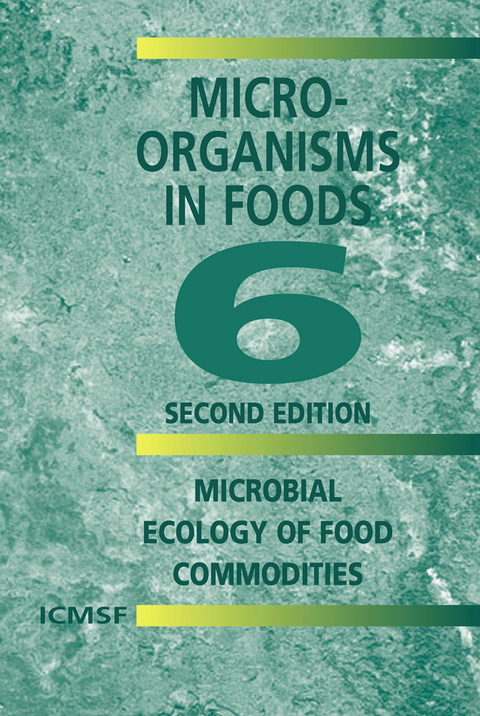
Microorganisms in Foods 6
Microbial Ecology of Food Commodities
Seiten
2005
|
2nd ed. 2005
Kluwer Academic/Plenum Publishers (Verlag)
978-0-306-48675-3 (ISBN)
Kluwer Academic/Plenum Publishers (Verlag)
978-0-306-48675-3 (ISBN)
Covering 17 commodity areas, this work describes the initial microbial flora and the prevalence of pathogens, the microbiological consequences of processing, typical spoilage patterns, episodes implicating those commodities with food borne illness, and measures to control pathogens and limit spoilage. It also includes a comprehensive index.
The second edition ofMicrobiologyofFoods6:MicrobialEcologyofFoodCommodities was written by the ICMSF, comprising 16 scientists from 11 countries, plus consultants and other contributors to chapters. The intention of the second edition was to bring the ?rst edition (published in 1996) up to date, taking into account developments in food processing and packaging, new products, and recognition of new pathogens and their control acquired since the ?rst edition. Theoverallstructure ofthechapters hasbeen retained,vizeachcovers(i)theimportantpropertiesof thefoodcommoditythataffectitsmicrobialcontentandecology,(ii)theinitialmicro?oraatslaughteror harvest, (iii) the effects of harvesting, transportation, processing, and storage on the microbial content, and (iv) an assessment of the hazards and risks of the food commodities and (v) the processes applied to control the microbial load. In 1980s, control of food safety was largely by inspection and compliance with hygiene regulations, together with end-product testing.MicroorganismsinFoods2:SamplingforMicrobiologicalAnalysis: PrinciplesandSpeci?cApplications(2nded.1
986)putsuchtestingonasounderstatisticalbasisthrough samplingplans,whichremainusefulwhenthereisnoinformationontheconditionsunderwhichafood has been produced or processed, e.g. at port-of-entry. At an early stage, the Commission recognized that no sampling plan can ensure the absence of a pathogen in food. Testing foods at ports of entry, or elsewhere in the food chain, cannot guarantee food safety.
The second edition ofMicrobiologyofFoods6:MicrobialEcologyofFoodCommodities was written by the ICMSF, comprising 16 scientists from 11 countries, plus consultants and other contributors to chapters. The intention of the second edition was to bring the ?rst edition (published in 1996) up to date, taking into account developments in food processing and packaging, new products, and recognition of new pathogens and their control acquired since the ?rst edition. Theoverallstructure ofthechapters hasbeen retained,vizeachcovers(i)theimportantpropertiesof thefoodcommoditythataffectitsmicrobialcontentandecology,(ii)theinitialmicro?oraatslaughteror harvest, (iii) the effects of harvesting, transportation, processing, and storage on the microbial content, and (iv) an assessment of the hazards and risks of the food commodities and (v) the processes applied to control the microbial load. In 1980s, control of food safety was largely by inspection and compliance with hygiene regulations, together with end-product testing.MicroorganismsinFoods2:SamplingforMicrobiologicalAnalysis: PrinciplesandSpeci?cApplications(2nded.1
986)putsuchtestingonasounderstatisticalbasisthrough samplingplans,whichremainusefulwhenthereisnoinformationontheconditionsunderwhichafood has been produced or processed, e.g. at port-of-entry. At an early stage, the Commission recognized that no sampling plan can ensure the absence of a pathogen in food. Testing foods at ports of entry, or elsewhere in the food chain, cannot guarantee food safety.
Meat and meat products.- Poultry products.- Fish and fish products.- Feeds and pet foods.- Vegetables and vegetable products.- Fruits and fruit products.- Spices, dry soups, and oriental flavorings.- Cereals and cereal products.- Nuts, oilseeds, and dried legumes.- Cocoa, chocolate, and confectionery.- Oil- and fat-based foods.- Sugar, syrups, and honey.- Soft drinks, fruit juices, concentrates, and fruit preserves.- Water.- Eggs and egg products.- Milk and dairy products.- Fermented beverages.
| Reihe/Serie | Microorganisms in Foods ; Vol.6 |
|---|---|
| Zusatzinfo | XVI, 764 p. |
| Verlagsort | New York |
| Sprache | englisch |
| Maße | 178 x 254 mm |
| Themenwelt | Technik ► Lebensmitteltechnologie |
| ISBN-10 | 0-306-48675-X / 030648675X |
| ISBN-13 | 978-0-306-48675-3 / 9780306486753 |
| Zustand | Neuware |
| Haben Sie eine Frage zum Produkt? |
Mehr entdecken
aus dem Bereich
aus dem Bereich
Technologie, Chemie, Mikrobiologie, Analytik, Bedeutung, Recht
Buch | Hardcover (2023)
Verlag Eugen Ulmer
CHF 169,00


